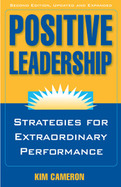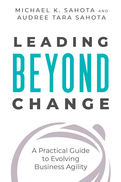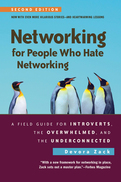You've been promoted to leadership—congratulations! But it's nothing like your old job, is it? William Gentry says it's time to flip your script.
We all have mental scripts that tell us how the world works. Your old script was all about “me”: standing out as an individual. But as a new leader, you need to flip your script from “me” to “we” and help the group you lead succeed. In this book, Gentry supports and coaches you to flip your script in six key areas. He offers actionable, practical, evidence-based advice and examples drawn from his research, his work with leaders, and his own failures and triumphs of becoming a new leader. Get started flipping your script and become the kind of boss everyone wants to work for.
2012
Beyond Success
Positive Leadership shows how to reach beyond ordinary success to achieve extraordinary effectiveness, spectacular results, and what Kim Cameron calls “positively deviant performance”—performance far above the norm. Citing a wide range of research in organizational behavior, medical science, and psychology as well as real-world examples, Cameron shows that to achieve exceptional success, leaders must emphasize strengths rather than simply focus on weaknesses; foster virtuous actions such as compassion, gratitude, and forgiveness; encourage contribution goals in addition to achievement goals; and enable meaningfulness in work. In this concise, inspiring, and practical guide, Cameron describes four positive leadership strategies, lays out a proven process for implementing them, and includes a self-assessment instrument. This second edition has been updated throughout with new research findings and new ideas for implementing positive leadership.
-
By the coauthor of Developing Management Skills (over 250,000 copies sold)
-
Draws on cutting-edge researchnot anecdotal personal storiesto show how to achieve success that far exceeds expectations
-
Updated throughout with new research findings and new ideas for implementing positive leadership
Leadership should be about much more than hitting targets and avoiding mistakes. Kim Cameron shows how to reach beyond ordinary success to achieve extraordinary effectiveness, spectacular results, and what he calls "positively deviant performance"performance far above the norm. Positive leadership enables thriving and flourishing rather than simply addressing obstacles and impediments. It helps bring out the best in human nature.
Cameron is one of the founders of the new field of Positive Organizational Scholarship, which studies unusually high-performing organizations. In Positive Leadership he draws on discoveries in this field and in the allied field of positive psychologywhich focuses on high-functioning individualsas well as positive organizational change methodologies. He identifies four interrelated
leadership strategies:
- Positive Climate: fostering emotions such as optimism, compassion, and gratitude
- Positive Relationships: building positive energy networks and developing strength-based activities
- Positive Communications: fostering best-self feedback and supportive communication patterns
- Positive Meaning: helping people find profound purpose and a sense of calling
Cameron cites the empirical research that these strategies are rooted in and that supports their bottom-line effectiveness, lays out a proven process for implementing them, and includes a self-assessment instrument and a guide to assist leaders in the implementation process. Positive Leadership is a concise, thoroughly researched, and practical guide that any leader can use to generate truly amazing results.
This guide shows readers how to transform a traditional organization into an evolutionary one with a framework and mindset that offer a new way of leading and approaching change.
Now more than ever, society is demanding change, and organizations are being asked to shift into more conscious and agile business practices. Yet, most of what people believe about leadership, effective workplaces, and how to create lasting change is either incomplete or outright incorrect. And even if the desire to change is there, understanding of how to achieve it is elusive.
This book holds the key. It introduces the Shift Evolutionary Leadership Framework (SELF), which helps leaders create the understanding and application needed to evolve high performance. At the core of the book are dozens of business patterns that cut across seven dimensions of organizational functioning. The traps of traditional organizations are contrasted with the high-performance practices of evolutionary organizations. Authors Michael Sahota and Audree Tata Sahota explain the steps of leading beyond change-evolving beyond servant leadership to make the inner shift needed to unlock the practical skills and techniques.
Whether readers call this shift business agility, Teal Agility, evolutionary, or the future of work, it is possible to create high-performing organizations filled with energized people who are able to surf the waves of change.
Zack politely examines and then smashes to tiny fragments the “dusty old rules” of standard networking advice. She shows how the very traits that make many people hate networking can be harnessed to forge an approach more effective and user-friendly than traditional techniques. This edition adds new material on applying networking principles in personal situations, handling interview questions, following up—what do you do with all those business cards?—and more.
Networking enables you to accomplish the goals that are most important to you. But you can't adopt a style that goes against who you are—and you don't have to. As Zack writes, “You do not succeed by denying your natural temperament; you succeed by working with your strengths.”
OST enables self-organizing groups of all sizes to deal with hugely complex issues in a very short period of time. This step-by-step user's guide details what needs to be done before, during, and after an Open Space event.
Harrison Owen details all the practical considerations necessary to create Open Space. He begins with the most important question—should you use Open Space at all?—and examines what types of situations are appropriate for Open Space Technology and what types are not. He then goes on to look at nuts-and-bolts issues such as supplies, logistics, and who should come and how you should go about getting them there.
This third edition adds a survey of the current status of Open Space Technology around the world, an updated section on the latest available technology for report writing (a key aspect of the Open Space process), and an updated list of resources.
Open Space Technology: A Users Guide is just what the name implies: a hands-on, detailed description of facilitating Open Space Technology (OST). OST is an effective, economical, fast, and easily repeatable strategy for organizing meetings of between 5 and 2,000 participants that has been used in thousands of organizations in 134 countries and just keeps growing in popularity. Written by the originator of the method, this is the most authoritative book on the rationale, procedures, and requirements of OST.
OST enables self-organizing groups of all sizes to deal with hugely complex issues in a very short period of time. This step-by-step users guide details what needs to be done before, during, and after an Open Space event.
Harrison Owen details all the practical considerations necessary to create Open Space. He begins with the most important questionshould you use Open Space at all?and examines what types of situations are appropriate for Open Space Technology and what types are not. He then goes on to look at nuts-and-bolts issues such as supplies, logistics, and who should come and how you should go about getting them there.
This third edition adds a survey of the current status of Open Space Technology around the world, an updated section on the latest available technology for report writing (a key aspect of the Open Space process), and an updated list of resources.
2024
We're often told that the key to success in life involves advancing in our careers, so why do feel stuck and unfulfilled when everything seems to be going right?
Adult development expert Maja Djikic explains that in order to discover our purpose and achieve real, lasting change, we need to move beyond narrowly targeted ideas and strategies like changing our mindset or slightly altering one aspect of our behavior. Instead, we need to go deeper and focus on our innate desires.
Djikic says that sustained change can only happen when our whole self moves holistically the same direction and at the same time. She introduces a transformational system called the Wheel of Change—a simple, five-segment plan that corresponds with the five key parts of ourselves: Desires, Actions, Emotions, Thoughts, and Body.
By understanding the mechanisms of these five integral parts, you will be able to escape the paradox of success without happiness and move towards your own path of fulfilling self-development.















